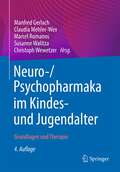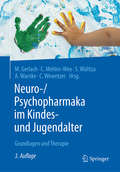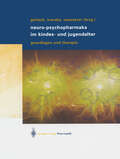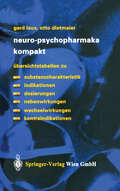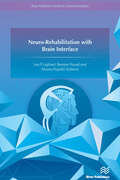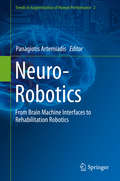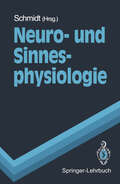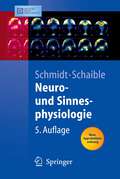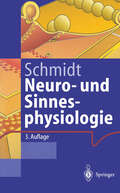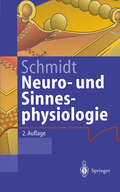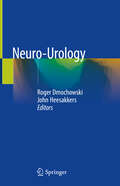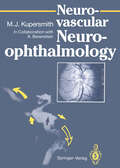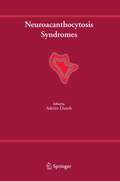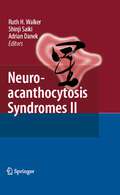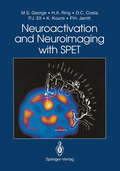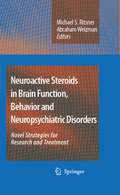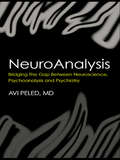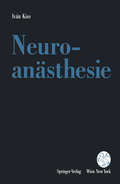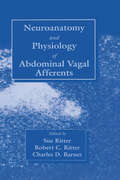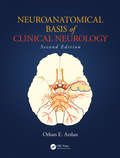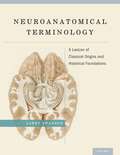- Table View
- List View
Neuro-/Psychopharmaka im Kindes- und Jugendalter: Grundlagen und Therapie
by Manfred Gerlach Claudia Mehler-Wex Marcel Romanos Susanne Walitza Christoph WewetzerDas Buch vermittelt aktuell und umfassend das Wissen auf dem Gebiet der Neuro-/Psychopharmakologie. Um ein tieferes Verständnis der Therapieprinzipien sowie der Besonderheiten der medikamentösen Behandlung bei Kindern und Jugendlichen zu erhalten, werden im ersten Teil die Grundlagen der Neuro-/Psychopharmakologie dargelegt. Zudem werden rechtliche und ethische Fragen im Praxisalltag eingehend erörtert. Der zweite Teil behandelt ausführlich die verschiedenen Arzneistoffgruppen. Im dritten Teil wird die störungsspezifische und symptomorientierte Medikation praxisorientiert beschrieben und kritisch bewertet, so dass der Arzt über eine klare Handlungsanleitung verfügt. Die vierte Auflage wurde aktualisiert und auf den neusten wissenschaftlichen Stand gebracht. Dieses Nachschlagewerk besticht durch die komprimierte und einheitliche Darstellung mit vielen zweifarbigen Tabellen, Schemata und Abbildungen. Es wendet sich an Kinder- und Jugendpsychiater und -psychotherapeuten, Pädiater, Allgemeinmediziner, Psychologen, Pflegekräfte und Lehrer.
Neuro-/Psychopharmaka im Kindes- und Jugendalter: Grundlagen und Therapie
by Manfred Gerlach Claudia Mehler-Wex Susanne Walitza Andreas Warnke Christoph WewetzerDieses Buch vermittelt einen umfassenden Überblick über das aktuelle Wissen auf dem Gebiet der Neuropsychopharmakologie im Kindes- und Jugendalter. Im ersten Teil werden die Grundlagen der Neuro-Psychopharmakologie dargelegt, um ein tieferes Verständnis der Therapieprinzipien sowie der Besonderheiten der Neuro-Psychopharmakologie bei Kindern und Jugendlichen zu erhalten. Rechtliche und ethische Fragen im Praxisalltag werden eingehend erörtert. Im speziellen Teil werden die verschiedenen Arzneistoffgruppen ausführlich behandelt. Im dritten Teil wird die störungsspezifische und symptomorientierte Medikation praxisorientiert beschrieben und kritisch bewertet, so dass der Arzt über eine klare Handlungsanleitung verfügt. Die 3. Auflage wurde aktualisiert und auf dem neusten wissenschaftlichen Stand gebracht. Dieses Nachschlagewerk besticht durch die komprimierte und einheitliche Darstellung mit vielen zweifarbigen Tabellen, Schemata und Abbildungen. Es wendet sich an Kinder- und Jugendpsychiater und -psychotherapeuten, Pädiater, Allgemeinmediziner, Psychologen, Pflegekräfte und Lehrer.
Neuro-Psychopharmaka im Kindes- und Jugendalter: Grundlagen und Therapie
by Manfred Gerlach Claudia Mehler-Wex Susanne Walitza Andreas Warnke Christoph WewetzerTherapieprinzipien und Besonderheiten schnell verstehen - dabei hilft die komprimierte und einheitliche Darstellung mit zahlreichen Tabellen, Abbildungen und klaren Handlungsanleitungen.
Neuro-Psychopharmaka im Kindes- und Jugendalter: Grundlagen und Therapie
by Manfred Gerlach Andreas Warnke Christoph WewetzerTherapieprinzipien und Besonderheiten schnell verstehen - dabei hilft die komprimierte und einheitliche Darstellung mit zahlreichen Tabellen, Abbildungen und klaren Handlungsanleitungen.
Neuro-Psychopharmaka kompakt: Übersichtstabellen zu Substanzcharakteristik, Indikationen, Dosierungen, Nebenwirkungen, Wechselwirkungen, Kontraindikationen
by Gerd Laux Otto DietmaierNeuro-Psychopharmaka zählen zu den meistverordneten Medikamenten, dennoch fällt vielen Ärzten der Überblick schwer. Das kompakte Taschenbuch enthält die praxis- und verordnungsrelevanten Fakten als tabellarische Kurzinformationen zu knapp 200 Einzelsubstanzen. Die im deutschen Sprachraum erhältlichen Neuro-Psychopharmaka sind alphabetisch nach ihren Internationalen Freinamen (INN) aufgeführt. Der Aufbau gliedert sich in 6 Spalten: - Freinamen (INN) alphabetisch, dazu Handelsnamen (D, A, CH) - Substanzcharakteristik (Pharmakologie, Indikationen, Wirkprofil) - Dosierung (einschließlich Eliminationshalbwertszeit) - häufige (> 10%) und typische Nebenwirkungen - klinisch relevante Interaktionen (Wechselwirkungen) - Kontraindikationen Alphabetische Register nach Freinamen und nach Handelsnamen sichern ein rasches Auffinden. Alle Ärzte, die Psychopharmaka verordnen, erhalten mit diesem übersichtlichen Kompendium einen handlichen Ratgeber mit den wichtigsten Basisdaten zur schnellen Information auf einen Blick.
Neuro-Rehabilitation with Brain Interface
by Leo P. Ligthart Ramjee Prasad Silvano PupolinIn recent years, major results were reported on Brain-Computer Interface / Brain-Machine Interface (BCI/BMI) applied to rehabilitation in scientific reports and papers. This subject received much attention within the Society on Communication, Navigation, Sensing and Services (CONASENSE) during the period 2013-2015. Describing the state of the art on various BCI/BMI activities related to neuro-rehabilitation is the central theme of this book.The latest insights coming from neurophysiologists, neuropsychologists, ICT experts specialized in clinical data management and from representatives of patient organizations are elucidated and new ways for “BCI/BMI applied to rehabilitation” using advanced ICT are introduced. The book describes the latest progress in and is an appeal for an approach leading to more cost-saving multi-disciplinary neuro-rehabilitation. This book covers the following topics: • Overview on BCI/BMI applied to rehabilitation• ICT for Neuro-rehabilitation• ICT for new generation prostheses• Gaze tracking, facial orientation determination, face and emotion recognition in 3D space for neuro-rehabilitation applications• Integrated perspective for future wide spread integration of motor neuro-rehabilitation• Ethical issues in the use of Information and Communication Technologies in the health care of patients with neurological disorders
Neuro-Rehabilitation with Brain Interface
In recent years, major results were reported on Brain-Computer Interface / Brain-Machine Interface (BCI/BMI) applied to rehabilitation in scientific reports and papers. This subject received much attention within the Society on Communication, Navigation, Sensing and Services (CONASENSE) during the period 2013-2015. Describing the state of the art on various BCI/BMI activities related to neuro-rehabilitation is the central theme of this book.The latest insights coming from neurophysiologists, neuropsychologists, ICT experts specialized in clinical data management and from representatives of patient organizations are elucidated and new ways for “BCI/BMI applied to rehabilitation” using advanced ICT are introduced. The book describes the latest progress in and is an appeal for an approach leading to more cost-saving multi-disciplinary neuro-rehabilitation. This book covers the following topics: • Overview on BCI/BMI applied to rehabilitation• ICT for Neuro-rehabilitation• ICT for new generation prostheses• Gaze tracking, facial orientation determination, face and emotion recognition in 3D space for neuro-rehabilitation applications• Integrated perspective for future wide spread integration of motor neuro-rehabilitation• Ethical issues in the use of Information and Communication Technologies in the health care of patients with neurological disorders
Neuro-Robotics: From Brain Machine Interfaces to Rehabilitation Robotics (Trends in Augmentation of Human Performance #2)
by Panagiotis ArtemiadisNeuro-robotics is one of the most multidisciplinary fields of the last decades, fusing information and knowledge from neuroscience, engineering and computer science. This book focuses on the results from the strategic alliance between Neuroscience and Robotics that help the scientific community to better understand the brain as well as design robotic devices and algorithms for interfacing humans and robots. The first part of the book introduces the idea of neuro-robotics, by presenting state-of-the-art bio-inspired devices. The second part of the book focuses on human-machine interfaces for performance augmentation, which can seen as augmentation of abilities of healthy subjects or assistance in case of the mobility impaired. The third part of the book focuses on the inverse problem, i.e. how we can use robotic devices that physically interact with the human body, in order (a) to understand human motor control and (b) to provide therapy to neurologically impaired people or people with disabilities.
Neuro- und Sinnesphysiologie (Springer-Lehrbuch)
by N. Birbaumer V. Braitenberg J. Dudel U. Eysel H. O. Handwerker H. Hatt M. Illert W. Jänig R. Rüdel R. F. Schmidt A. Schüz H. P. ZennerDieses Buch informiert über die gesicherten Grundlagen und die wesentlichsten neueren Ergebnisse der Erforschung des peripheren und zentralen Nervensystems und der Sinnesorgane des Menschen. Dabei wurde der Umfang so begrenzt, daß der Inhalt in angemessener Zeit aufgenommen werden kann. Das Buch setzt praktisch keine anatomischen oder physiologischen Vorkenntnisse voraus. Alle Leser, die das Abitur oder diesem vergleichbare Kenntnisse der Naturwissenschaften besitzen, können sich den Inhalt somit ohne Verständnisschwierigkeiten aneignen. Dabei wird der Lernprozeß durch die Didaktik des Lehrbuches und die zahlreichen vierfarbigen Abbildungen zusätzlich unterstützt. Alle zwölf Autoren dieses Buches gelten international als besonders kompetente Fachleute auf ihrem jeweiligen Forschungsgebiet. Damit ist gewährleistet, daß dieses Lehrbuch nicht nur die wesentlichen Fakten und Hypothesen der Neuro- und Sinnesphysiologie vermittelt, sondern darüber hinaus auch an die noch offenen Fragen der Hirnforschung heranführt. Somit wendet sich dieses Werk neben Medizinstudenten auch an Physiologiestudenten anderer Fachgebiete wie Biologie, Psychologie, Zahnmedizin und Pharmazie.
Neuro- und Sinnesphysiologie (Springer-Lehrbuch)
by Niels Birbaumer V. Braitenberg H. Brinkmeier J. Dudel U. Eysel H. O. Handwerker H. Hatt M. Illert W. Jänig J.P. Kuhtz-Buschbeck R. Rüdel H. G. Schaible R. F. Schmidt A. Schütz H. P. ZennerNeuro- und sinnesphysiologische Vorgänge sind die Basis unseres Bewusstseins und Verhaltens. Das moderne, faszinierende Fachgebiet der Medizin ist von grundlegender Bedeutung für das Verständnis neurologischer, psychologischer und psychiatrischer Fragestellungen. 15 fachlich renommierte Autoren der Physiologie haben ein Lehrbuch geschaffen, das durch die Knappheit und Präzision der Darstellung ebenso besticht, wie durch sein didaktisches Konzept und die Fülle klarer, 4-farbiger Abbildungen. Neu in der 5. Auflage sind gemäß der neuen Approbationsordnung die klinisch-pathophysiologischen Elemente. In erster Linie wendet sich dieses Taschenbuch an Medizinstudenten. Aber auch Studenten der Biologie, Psychologie, Zahnmedizin und Pharmazie erleichtert der Schmidt/Schaible den Einstieg in die Neuro- und Sinnesphysiologie, denn die Autoren setzen keine anatomischen oder physiologischen Kenntnisse voraus.
Neuro- und Sinnesphysiologie (Springer-Lehrbuch)
by Robert F. SchmidtNeuro- und sinnesphysiologische Vorgänge bilden die Basis unseres Bewußtseins und Verhaltens. Die ebenso komplexe wie faszinierende Thematik dieses Lehrbuchs ist deshalb von grundlegender Bedeutung für das Verständnis neurologischer, psychologischer und psychiatrischer Problemstellungen. Zwölf fachlich besonders kompetente Autoren haben ein Lehrbuch geschaffen, welches durch die Knappheit und Präzision der Darstellung ebenso besticht, wie durch sein didaktisches Konzept und die Fülle klarer, vierfarbiger Abbildungen. In erster Linie wendet sich dieses Taschenlehrbuch an Medizinstudenten. Aber auch Studenten der Biologie, Psychologie, Zahnmedizin oder Pharmazie wird es den Einstieg in die Neuro- und Sinnesphysiologie erleichtern, da kaum anatomische oder physiologische Vorkenntnisse benötigt werden.
Neuro- und Sinnesphysiologie (Springer-Lehrbuch)
by Robert F. SchmidtNeuro- und sinnesphysiologische Vorgänge bilden die Basis unseres Bewußtseins und Verhaltens. Die ebenso komplexe wie faszinierende Thematik dieses Lehrbuchs ist deshalb von grundlegender Bedeutung für das Verständnis neurologischer, psychologischer und psychiatrischer Problemstellungen. Zwölf fachlich besonders kompetente Autoren haben ein Lehrbuch geschaffen, welches durch die Knappheit und Präzision der Darstellung ebenso besticht, wie durch sein didaktisches Konzept und die Fülle klarer, vierfarbiger Abbildungen. In erster Linie wendet sich dieses Taschenlehrbuch an Medizinstudenten. Aber auch Studenten der Biologie, Psychologie, Zahnmedizin oder Pharmazie wird es den Einstieg in die Neuro- und Sinnesphysiologie erleichtern, da kaum anatomische oder physiologische Vorkenntnisse benötigt werden.
Neuro-Urology
by Roger Dmochowski John HeesakkersThis volume is a useful handbook for medical doctors involved in the diagnosis and treatment of neuro-urological problems. The first section reviews the relevant neuro-anatomy and neuro-physiology and provides a practical overview of specific neuro-urological pathologic conditions. The second section discusses the various clinical entities that can be encountered and focuses on the clinical entities neuro-urological consquences. The third section is devoted to the different diagnostic possibilities. Internationally accepted algorithms are presented and put into perspective. Section 4 deals with the triad of major clinical problems in this area: urinary (incontinence, retention and voiding dysfunction as well as upper urinary tract problems), anorectal (faecal incontinence and constipation) and sexual (erectile dysfunction and ejaculatory failure) dysfunctions. The final section covers the specific management of patients with neuro-urological problems and describes conservative and surgical treatments, providing the most recent information. Throughout, the text is accompanied by numerous illustrated case reports and discussions as well as tips and tricks based on the personal experience of the different authors.
Neuro-vascular Neuro-ophthalmology
by Mark J. KupersmithNeuro-ophthalmological symptoms frequently arise in disorders which alter the intracranial and intraorbital circulation. Because of the wide range of sensory and cognitive systems involved in vision and eye movements, visual disturbances are typically found in the common vascular disorders, such as atherosclerosis, migraine, and aneurysms, but can also result from practically any, common or rare,local or systemic vascular disorder. The dysfunction can be part of a largersyndrome or the predominant clinical abnormality. Many of the newer concepts concerning the diagnosis and treatment of neurovascular disorders have evolved in consequence of advances in techniques for neuroimaging such as MRI; methods of measuring systemic coagulation and inflammation; and superselective catheterization ofabnormal blood vessels and vascular lesions. The neuroophthalmological evaluation of clinical signs and symptoms often leads to accurate localization and diagnosis of the lesion. Many of these clinical abnormalities, such as visual field defects and ocular misalignments, can be quantified and followed to assess either the natural history of the disorder or the effects of therapies. No one medical specialty can manage these neurovascular neuro-ophthalmological disorders alone. The complexity of diagnosis and treatment planning requires a multi- disciplinary team. This approach, bringing ophthalmologists, neurosurgeons, and neurologists together to confer in the management of these cases, has been pioneered by the authors' group at the New York University Medical Center.
Neuroacanthocytosis Syndromes
by Adrian DanekNeuroacanthocytosis Syndromes is the first comprehensive review of a field that has not yet received the attention it deserves. Affecting the brain as well as the circulating red cells, these multi-system disorders in the past had often been mistaken for Huntington's disease. Recent breakthroughs have now identified the molecular basis of several of these. This volume grew out of the first international scientific meeting ever devoted to neuroacanthocytosis and provides in-depth information about the state of the art. Its thirty chapters were written by the leading authorities in the field to cover the clinical as well as the basic science perspective, including not only molecular genetics but also experimental pharmacology and cell membrane biology, among others. The book vehemently poses the question of how the membrane deformation of circulating red blood cells relates to degeneration of nerve cells in the brain, the basal ganglia, in particular. It provides a wealth of data that will help to solve an intriguing puzzle and ease the suffering of those affected by one of the neuroacanthocytosis syndromes.
Neuroacanthocytosis Syndromes II
by M. HallettThe latest research regarding the neurodegenerative conditions known as neuroacanthocytosis will be found in this book. Recent advances have identified the range of mutations in the causative genes. In vitro studies have identified potential protein interactions, and work on erythrocyte membranes suggests mechanisms for the generation of acanthocytes. Animal models are being generated and provide the foundation for possible therapeutic interventions.
Neuroactivation and Neuroimaging with SPET
by Mark S. George Howard A. Ring Durval C. Costa Peter J. Ell Kypros Kouris Peter H. JarrittRecent explorations in the neurosciences have been progressing towards an understanding of the relationship between brain struc ture and brain function. Having passed through an era which may be described as one of a localisationist philosophy, in which discrete brain areas were seen to subserve only discrete functions, the perspective of brain-behaviour relationships has advanced in recent years to an appreciation that a more holistic approach is not only heuristically valid, but is also most likely to lead to future advances. The close relationship between the mind and the brain has been appreciated since the time of Hippocrates when he opined 'men ought to know that from nothing else but thence [from the brain] comes joys, delights, laughter and sports, and sorrows, griefs, despondency and lamentations ... and by this same organ we become mad and delirious and fears and terrors assail us'. In the nineteenth century, particularly in France and Germany, descrip tions of what are now recognised to be independent neurological diseases emerged following empirical clinical observations. Investi gation led to the identification in many cases of underlying struc tural abnormalities which could be linked to pathological changes.
Neuroactive Steroids in Brain Function, Behavior and Neuropsychiatric Disorders: Novel Strategies for Research and Treatment
by Abraham WeizmanThis book provides an up-to-date overview of the role of neurosteroids and neuroactive steroids in the regulation of brain processes and neuropsychiatric disorders. It addresses the neurosteroid function in brain development and plasticity, in both the normal and the pathological brain. It also suggests possible therapeutic approaches to the use of natural occurring or sinthetic neurosteroids. The contributors suggest that neuroactive steroids could have a role in clinical practice.
NeuroAnalysis: Bridging the Gap between Neuroscience, Psychoanalysis and Psychiatry
by Avi PeledNeuroAnalysis investigates using the neural network and neural computation models to bridge the divide between psychology, psychoanalysis, and neuroscience when diagnosing mental health disorders and prescribing treatment. Avi Peled builds on Freud's early attempts to explain the neural basis of mental health by introducing neural computation as a bridging science to explain psychiatric disorders. Peled describes the brain as a complex system of interconnected units and goes on to suggest that conscious experience, feelings, and mood are emergent properties arising from these complex organisations. This model describes mental health disorders in terms of perturbation to the optimal brain organisation, and demonstrates how particular disorders can be identified through a specific breakdown pattern of the brain’s organisation. This fresh approach to the diagnosis of psychiatric disorders will interest students, professors, and researchers of psychoanalysis, neuroscience, and their related fields.
NeuroAnalysis: Bridging the Gap between Neuroscience, Psychoanalysis and Psychiatry
by Avi PeledNeuroAnalysis investigates using the neural network and neural computation models to bridge the divide between psychology, psychoanalysis, and neuroscience when diagnosing mental health disorders and prescribing treatment. Avi Peled builds on Freud's early attempts to explain the neural basis of mental health by introducing neural computation as a bridging science to explain psychiatric disorders. Peled describes the brain as a complex system of interconnected units and goes on to suggest that conscious experience, feelings, and mood are emergent properties arising from these complex organisations. This model describes mental health disorders in terms of perturbation to the optimal brain organisation, and demonstrates how particular disorders can be identified through a specific breakdown pattern of the brain’s organisation. This fresh approach to the diagnosis of psychiatric disorders will interest students, professors, and researchers of psychoanalysis, neuroscience, and their related fields.
Neuroanästhesie
by Ivan KissDas Buch ist die erste deutschsprachige, klinische Monographie über Neuroanästhesie. Im Rahmen der perioperativen anästhesiologischen Tätigkeit werden die Möglichkeiten der Senkung des intrakraniellen Druckes gesondert diskutiert. Die praktischen, anästhesiologischen Aspekte der einzelnen diagnostischen und operativen Eingriffe werden systematisch dargestellt. Bei der Planung der Anästhesie wird ein zweifaches Ziel verfolgt: Optimale Patientensicherheit und bestmögliche operative Verhältnisse. Entsprechend der Entwicklung der Neurochirurgie und Neuroanästhesie in den achtziger Jahren, werden die bewährten und neu etablierten Methoden hervorgehoben. Diese subjektive Auswahl unterliegt der klinischen Erfahrung des Autors und der Literatur.
Neuroanat and Physiology of Abdominal Vagal Afferents
by Sue Ritter Robert C. Ritter Charles D. BarnesNeuroanatomy and Physiology of Abdominal Vagal Afferents provides a concise, up-to-date selection of focused reviews of vagal sensory participation in control of gastrointestinal function and behavior. The articles, written by internationally recognized leaders in the field, examine the types of information carried by vagal sensory neurons from the gastrointestinal tract, how the vagal sensory and motor components are arranged and interact with the brain, and the nature of vagal sensory participation in selected aspects of physiology and behavior. Future avenues of research in the area of vagal neuroanatomy and physiology are suggested.Neuroanatomy and Physiology of Abdominal Vagal Afferents is a detailed, informative volume that will benefit neurobiologists, GI physiologists, behavioral scientists, and research gastroenterologists.
Neuroanat and Physiology of Abdominal Vagal Afferents
by Sue Ritter Robert C. Ritter Charles D. BarnesNeuroanatomy and Physiology of Abdominal Vagal Afferents provides a concise, up-to-date selection of focused reviews of vagal sensory participation in control of gastrointestinal function and behavior. The articles, written by internationally recognized leaders in the field, examine the types of information carried by vagal sensory neurons from the gastrointestinal tract, how the vagal sensory and motor components are arranged and interact with the brain, and the nature of vagal sensory participation in selected aspects of physiology and behavior. Future avenues of research in the area of vagal neuroanatomy and physiology are suggested.Neuroanatomy and Physiology of Abdominal Vagal Afferents is a detailed, informative volume that will benefit neurobiologists, GI physiologists, behavioral scientists, and research gastroenterologists.
Neuroanatomical Basis of Clinical Neurology
by Orhan E. ArslanBridging the gap between the peripheral and central nervous systems, the second edition of Neuroanatomical Basis of Clinical Neurology enriches understanding of neurological conditions through a conceptual approach to neuronal circuitry. The book retains the basic outline of contents from the first edition, integrating structural organization with
Neuroanatomical Terminology: A Lexicon of Classical Origins and Historical Foundations
by Larry SwansonHuman brain imaging, connectomics, network analysis, and neuroinformatics are just some of the important current arenas in neuroscience addressed here. The book solves a fundamental problem by supplying the first global, historically documented, hierarchically organized human nervous system parts list. This defined vocabulary accurately and systematically describes every human nervous system structural feature that can be observed with current imaging methods, and provides an extendible framework for describing accurately the nervous system in all animals including invertebrates and vertebrates alike. Research for the book began in the late 1990s when the lack of a systematic vocabulary for neuroanatomy became a critical problem in developing databases and online knowledge management systems for the NIH Human Brain Project (1995-2005), which grew out of the Institute of Medicine's Committee on a National Neural Circuitry Database (1989). One outcome of this research was the publication with Mihail Bota in 2011 of a Foundational Model of Connectivity. It provides the conceptual framework for this book, which is divided into three main parts. The first consists of four chapters discussing the rationale behind the Lexicon of nervous system parts, historical trends in the evolution of neuroanatomical concepts and nomenclature, the development of hierarchical nomenclature tables, and practical notes on using the Lexicon. The second part is the Lexicon itself, with separate entries for 1,381 standard terms. Each standard term has a textual definition including the method used for identification, age, sex, and species to which it applies, and a citation to the first use of the term as so defined. Each entry also has, where appropriate, chronological lists of nonstandard terms (10,928 in all): translations, alternate spellings, earlier delineations before naming, earlier synonyms, later synonyms, and partly corresponding terms. The third part is a set of 10 hierarchical nomenclature tables of nervous system standard terms.
